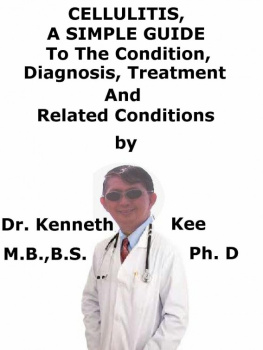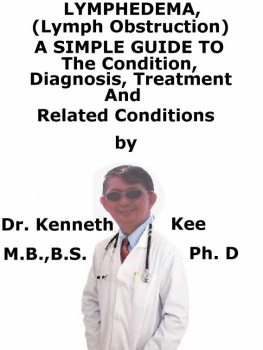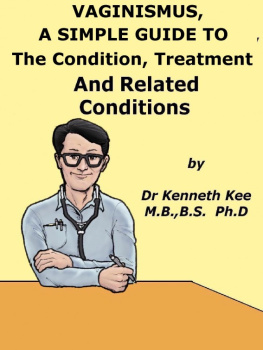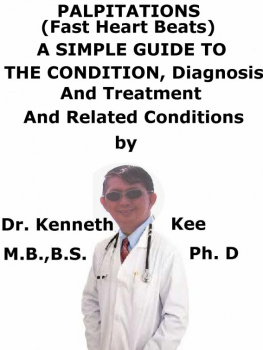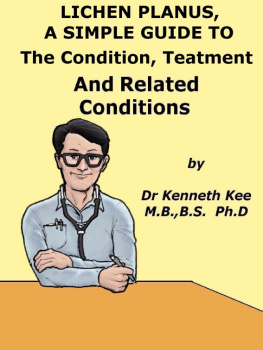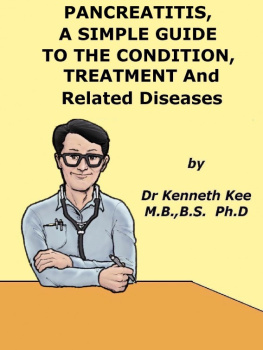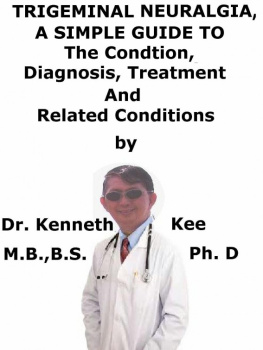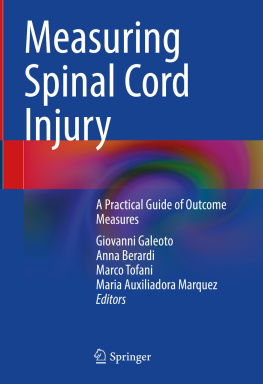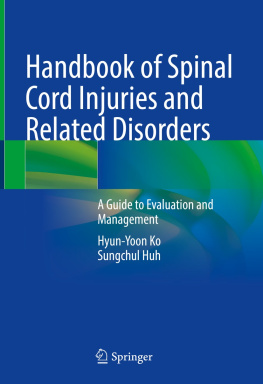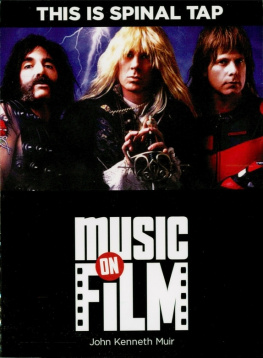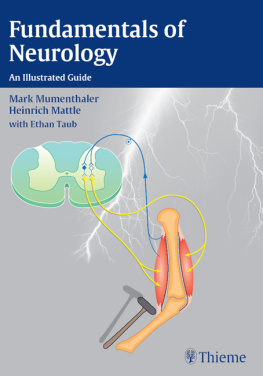Syringomyelia
A
Simple
Guide
To
The Condition,
Treatment
And
Related Diseases
By
Dr Kenneth Kee
M.B.,B.S. (Singapore)
Ph.D (Healthcare Administration)
Copyright Kenneth Kee 2014 SmashwordsEdition
Published By Kenneth Kee atSmashwords.com
Dedication
This book is dedicated
To my wife Dorothy
And my children
Carolyn, Grace
And Kelvin
This book describes the Syringomyelia,Treatment and Associated Diseases or in vernacular terms
(What You Need to Treat Syringomyelia)
This eBook is licensed for the personalenjoyment only. This eBook may not be re-sold or given away toother people. If you would like to share this book with anotherperson, please purchase an additional copy for each reader.
If youre reading this book and did notpurchase it, or it was not purchased for your use only, then pleasereturn to Smashwords.com and purchase your own copy.
Thank you for respecting the hard work ofthis author.
Introduction
Ode To Syringomyelia Syringomyelia is a disorder in which a cystforms within the spinal cord This cyst called a syrinx puts pressure onthe spinal tissues and nerve blocks Damage to the spinal cord often leads toprogressive weakness In the back, shoulders, and extremities,syringomyelia can cause stiffness. Congenital cause is due to a brainabnormality called an ArnoldChiari malformation Acquired syringomyelia occurs as a traumatic,meningitic, hemorrhagic complication Symptoms include pain, numbness, weakness,and temperature disruption Syringomyelia can also adversely affectbowel, bladder and sexual function Diagnosis of syringomyelia is now by (MRI)magnetic resonance imaging, The first step after diagnosis is finding aneurosurgeon for removing the syrinx. Surgery results in stabilization or modestimprovement in symptom.
Draining syrinx fluid uses a shunt of CSFfrom the brain to the abdomen. -An original poem by Kenneth Kee Interesting Tips about the Syringomyelia A Healthy Lifestyle 1. Take a well Balanced Diet 2. Treatment of Syringomyelia: Surgery is usually recommended forindividuals with syringomyelia. The type of surgery and its location dependon the type of syringomyelia. In Chiari malformation, the main goal ofsurgery is to provide more space at the base of the skull and upperneck without entering the brain or spinal cord.
This results in the primary cyst becomingmuch smaller Surgery results in stabilization or modestimprovement in symptoms for most individuals with Chiarimalformation. Delay in treatment may result in irreversiblespinal cord injury. Recurrence of syringomyelia after surgery maymake additional operations necessary; these may not be completelysuccessful over the long term. In some individuals it may be necessary todrain the syrinx, which can be accomplished using a catheter,drainage tubes, and valves. This system is known as a shunt. Shunts are used in both the communicating andnon-communicating forms of the disorder.
First, the surgeon must locate thesyrinx. Then, the shunt is placed into it with theother end draining the syrinx fluid into a cavity, usually theabdomen. This type of shunt is called asyringoperitoneal shunt. A shunt of CSF from the brain to the abdomenis called a ventriculoperitoneal shunt and is used in casesinvolving hydrocephalus. By draining syrinx fluid or CSF, a shunt canhalt the progression of symptoms and relieve pain, headache, andtightness. 3.
Keep bones and body strong Bone marrow produces our blood Eat foods rich in calcium like yogurt,cheese, milk, and dark green vegetables. Eat foods rich in Vitamin D, like eggs, fattyfish, cereal, and fortified milk. Eat food rich in Vitamins B and C such asgreen vegetables and fruits Zinc and other minerals are important to thebody 4. Get enough rest and Sleep Avoid stress and tension 5. Exercise and stay active. It is best to do weight-bearing exercise suchas walking, jogging, stair climbing, dancing, or lifting weightsfor 2 hours a week.
One way to do this is to be active 30 minutesa day at least 5 days a week. Begin slowly especially if a person has notbeen active. 6. Do not drink more than 2 alcohol drinks aday for a man or 1 alcohol drink a day for a woman. Alcohol can affect the neurons and braincells. 7.
Stop or do not begin smoking. It also interferes with blood supply andhealing.
Chapter 1
What is syringomyelia? Syringomyelia is a disorder in which a cystforms within the spinal cord. This cyst called a syrinx expands andelongates over time, destroying a portion of the spinal cord fromits center and expanding outward. As a syrinx widens it compresses and injuresnerve fibers that carry information from the brain to theextremities. Damage to the spinal cord often leads toprogressive weakness in the arms and legs, stiffness in the back,shoulders, arms, or legs and chronic severe pain.
Other symptoms may include headaches, a lossof the ability to feel extremes of hot or cold (especially in thehands), and loss of bladder and other functions. Each individual experiences a differentcombination of symptoms depending on where in the spinal cord thesyrinx forms and how far it extends. Signs of the disorder tend to develop slowly,although sudden onset may occur with coughing or straining. Many disorders share the early symptoms ofsyringomyelia which also can occur in association with otherconditions. Estimates of the number of Americans withsyringomyelia vary widely but a conservative estimate is that about40,000 people in the United States are affected, with symptomsusually beginning in young adulthood. Some cases of syringomyelia occur in morethan one family member although this is rare.
What causessyringomyelia? A watery, protective substance known ascerebrospinal fluid (CSF) normally flows around the spinal cord andbrain transporting nutrients and waste products. It also acts as a cushion to protect thebrain and spinal cord. In early development, CSF also fills a smallcanal that runs through the center of the spinal cordthe centralcanalwhich then collapses normally over time. A number of medical conditions can cause anobstruction in the normal flow of CSF, redirecting excess fluidinto the spinal cord and central canal. This redirected CSF accumulates within thetissue of the spinal cord and forms a fluid-filled syrinx. Pressure differences along the spine causethe fluid to move within the syrinx and outside the spinalcord.
Physicians believe that this continualmovement of fluid in and around the spinal cord results in cystgrowth and further damage to the spinal cord tissue. What are thedifferent forms of syringomyelia? Generally, there are two forms ofsyringomyelia. In most cases, the disorder is related to anabnormality of the brain called a Chiari I malformation, namedafter one of the physicians who first characterized it. This anatomic abnormality causes the lowerpart of the cerebellum to protrude from its normal location in theback of the head into the cervical or neck portion of the spinalcanal. A syrinx may then develop in the cervicalregion of the spinal cord. Because of the relationship that was oncethought to exist between the brain and spinal cord in this type ofsyringomyelia, physicians sometimes refer to it as communicatingsyringomyelia.
Symptoms usually begin between the ages of 25and 40 and may worsen with straining or any activity that causesCSF pressure to fluctuate suddenly. Some individuals, however, may have longperiods of functional stability. Some people with this form of the disorderalso have hydrocephalus in which CSF accumulates in the brain, or acondition called arachnoiditis, in which a covering of the spinalcordthe arachnoid membraneis inflamed. The second major form of syringomyelia occursas a complication of trauma, meningitis, hemorrhage, a tumor orarachnoiditis. Here the syrinx or cyst develops in a segmentof the spinal cord damaged by one of these conditions. The syrinx then starts to expand.


